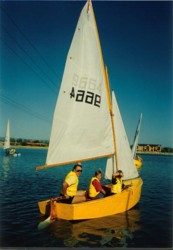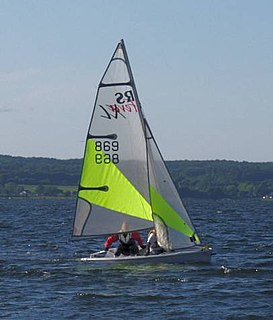Related Research Articles
The Mirror is a popular sailing dinghy with more than 70,000 built.

The Heron Dinghy is a dinghy designed by Jack Holt of the United Kingdom as the Yachting World Cartopper. The Heron dinghy was designed to be built by a home handyman out of marine ply over a timber frame, but can now also be constructed from marine ply using a stitch and glue technique or from Fibreglass. Modern dinghies will usually have built in buoyancy tanks, older craft will have bags or retrofitted tanks.

The Laser is a widely used class of single-handed, one-design sailing dinghies using a common hull design with three interchangeable rigs of different sail areas, appropriate to a given combination of wind strength and crew weight. Bruce Kirby designed the Laser in 1970 with an emphasis on simplicity and performance.
The Portsmouth Yardstick (PY) or Portsmouth handicap scheme is a term used for a number of related systems of empirical handicapping used primarily in small sailboat racing.

The Wayfarer is a wooden or fibreglass hulled fractional Bermuda rigged sailing dinghy of great versatility; used for short 'day boat' trips, longer cruises and for racing. Over 11,000 have been produced as of 2016.

The 470 (Four-Seventy) is a double-handed monohull planing dinghy with a centreboard, Bermuda rig, and centre sheeting. Equipped with a spinnaker, trapeze and a large sail-area-to-weight ratio, it is designed to plane easily, and good teamwork is necessary to sail it well. The name comes from the boat's length of 470 centimetres.

The Optimist, also known as the ‘opti’, or 'oppie', is a small, single-handed sailing dinghy intended for use by children and teenagers up to the age of 15. Contemporary boats are usually made of fibreglass, although wooden boats are still built.
Jack Holt, OBE was a prolific designer of sailing dinghies. His pioneering designs of dinghies using plywood did much to popularise the sport of sailing in the period immediately following World War II.

The 49er and 49er FX is a two-handed skiff-type high-performance sailing dinghy. The two crew work on different roles with the helm making many tactical decisions, as well as steering, and the crew doing most of the sail control. Both of the crew are equipped with their own trapeze and sailing is done while cantilevered over the water to the fullest extent to balance against the sails.

The Flying Dutchman (FD) is a 20-foot one-design high-performance two-person monohull racing dinghy. Developed in the early 1950s in the Netherlands, its large sail area per unit weight allow it to plane easily when sailing upwind. The boat utilizes a trapeze harness for the crew and hiking straps for the skipper to counterbalance the wind force on its sails. It made its Olympic debut at the 1960 Olympic Games.

The Byte is a small one-design sailing dinghy sailed by one person. It was designed by Canadian Ian Bruce, who also commissioned and marketed the Laser.

The Cadet is a class of sailing dinghy designed to be sailed by two children up to the age of 17. It is a one-design class, originally designed by Jack Holt in 1947. Cadets are sailed worldwide in more than 40 countries.

The Laser Pico dinghy is a small sailboat designed by Jo Richards in the mid-1990s and used primarily for training and day sailing. It can be crewed by one or two children or an adult. Current models come equipped with both a mainsail and a jib, the jib however mainly functions as a training tool and provides little to no contribution to speed. The Pico functions mainly as a training boat for younger children because of its very durable nature and has little to no racing events dedicated to it.

The Fireball is a British sailing dinghy that was designed by Peter Milne as a one-design racer and first built in 1962.

The Laser Stratos is an all-round cruising and racing boat designed by Phil Morrison and built by Laser Performance, the same company as the famous Laser Standard dinghy. It is built from fibre-glass and foam sandwich. The Laser Stratos comes in two forms, one with a keel and one with a centreboard. The centreboard version is red and the keel version is blue. The Stratos is quite spacious and most of the rigging is kept out of the way. The boat can optionally be fitted with trapeze lines and an engine bracket for carrying an outboard engine.

The Moth is a small development class of sailing dinghy. Originally a small, fast home-built sailing boat designed to plane, since 2000 it has become an expensive and largely commercially-produced boat designed to hydroplane on foils though many are still built at home, typically at much lower cost.

The Cherub is a 12 feet long, high performance, two-person, planing dinghy first designed in 1951 in New Zealand by John Spencer. The class is a development class, allowing for significant variation in design between different boats within the rule framework. The minimum hull weight was originally 110 lbs.

The RS Feva is a two-person sailing dinghy designed by Paul Handley in 2002. It is manufactured and distributed by RS Sailing. The RS Feva is an International Sailing Federation (ISAF) International Class, a Royal Yachting Association (RYA) Supported Junior Class, and has been selected by the Dansk Sejlunion and Norges Seilforbund for major sailing growth projects.
The Splash Dinghy is 3.5 m in length and all boats are identical, thus, as is typical in One-Design classes, the sailor's ability rather than equipment is emphasised fleet racing. The boats employ an un-stayed mono rig with a sail area of 6.3 m2, which makes the class easy to handle by sailors ranging from 45 to 80 kg. This, combined with the low hull weight of 55 kg, allow the class to serve as a stepping stone between the Optimist Dinghy and boats such as the Laser Radial, suiting sailors in the age range from 13 to 21 years.

The B14 is a two man monohull dinghy, designed by Julian Bethwaite. It is recognised as an international class by the International Sailing Federation. The boat was designed in 1984.
References
- ↑ "History of the Pacer Class". pacersailing.org.au. Pacer Sailing Australia. Archived from the original on 13 September 2009. Retrieved 17 January 2010.
- ↑ "The Pacer". YACHTe. Archived from the original on 30 October 2009. Retrieved 17 January 2010.
- ↑ "The RYA Portsmouth Yardstick Number List for 2004" (PDF). Royal Yachting Association. Archived from the original (PDF) on 4 March 2016. Retrieved 22 August 2012.